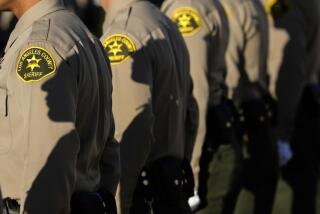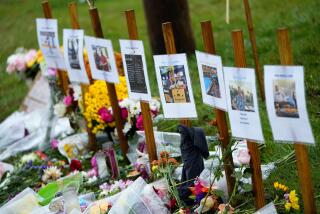Inquiry Clears Reserve Unit of Racism Allegation
The state adjutant general’s office reported Friday that an investigation found no evidence to support accusations that a training lecture to a State Military Reserve unit at Van Nuys Airport in January included anti-black and anti-Jewish material.
An investigation by inspectors of the California National Guard and the State Military Reserve concluded that “there was nothing racial or prejudicial in either the films or the lecture presented at the training session,” said Sgt. Carolyn Hamilton, a spokeswoman for the adjutant general.
No further action is expected in the case, she said.
The accusations were made in a letter to the adjutant general, Maj. Gen. Willard A. Shank, by Eric G. Forster of Santa Monica, an executive at a Calabasas bank. Forster was a first lieutenant in the 3rd Aviation Group of the State Military Reserve, a little-known auxiliary to the California National Guard.
The adjutant general commands the reserve as well as the California National Guard and California Air National Guard.
Complained in Letter
Forster, an Israeli-born Jew who said he is a former warrant officer in the Israeli Air Force, complained in his letter that a uniformed instructor told a group of about 50 members of the unit in an anti-terrorism lecture on Jan. 18 that:
“Israel has been selling U. S. military intelligence secrets to the Soviet Union for the last 20 years . . . that Israel is alone responsible for the inferior U. S. military posture vis-a-vis the Soviet Union, and that American Jews have been known to supply Israel and Russia with military secrets.”
Forster wrote that the lecturer showed videotapes with “anti-black, racist segments.” In an interview, Forster said the videotapes contained insulting caricatures of blacks and asserted “that American blacks had been recruited by the Soviet Union as terrorists.”
The investigation was carried out by Col. Donald R. McCormick, inspector general of the California National Guard, and a state reserve inspector, Maj. OrelHarper, Hamilton said.
She said 17 members of the unit who were present, including one black and six other Jews, told the investigators that they did not hear any such statements.
“None of the 17 took any offense at any of the material presented,” she said.
The lecture was given by Richard Callaghan, a Costa Mesa real estate agent who is a lieutenant colonel in the military reserve.
Callaghan said Friday that he was embarrassed by Forster’s accusations but was not surprised at the result of the investigation.
‘I Was There’
“I was never worried,” he said. “I knew what happened. I was there.”
Callaghan said he spent 16 years in law enforcement--including service with the Las Vegas Police Department, as police chief of Payette, Ida., and as an investigator for the California Department of Alcoholic Beverage Control--and is a recognized authority on terrorism.
He has given the same lecture hundreds of times to military and civilian audiences and has never had a complaint like Forster’s, he said.
Forster complained that one of the videotapes shown by Callaghan was produced by the Western Goals Foundation, a political group founded in 1979 by the late Rep. Larry P. McDonald (D-Ga.), who was then chairman of the John Birch Society. McDonald and 268 others died when a Soviet fighter plane shot down a Korean jetliner in 1983.
The adjutant general’s office and Callaghan confirmed that the videotape was produced by Western Goals. Callaghan said the tape was a historical review of terrorist actions, with graphic pictures of victims, but that it contained no racially oriented material. “It’s obviously anti-communist, but, other than that, there’s nothing political in the film,” he said.
The other videotape, “The KGB Connection,” produced by the Canadian Broadcasting Corp., includes an interview with a black American who once worked for the Castro government. The man, now a university professor, speaks in favor of a revolution in the United States by blacks against whites, Callaghan said. Callaghan said he suspects Forster misinterpreted the message of the videotape, which was to illustrate communist infiltration of American institutions.
“There are no black-white issues in the film, except for what this one guy says,” Callaghan said. “And he certainly didn’t slur blacks.”
Forster also alleged that newspapers of a neo-Nazi group were available at the group’s monthly training sessions in the past.
Right-Wing Newspapers
Hamilton said the investigators concluded that newspapers “of a right-wing nature” were placed at meeting sites “about 18 months ago, by an individual who is no longer a member of the reserve.” The newspapers “were at no time passed out, handed out or used in any way” and the reservist suspected of bringing them resigned for unrelated reasons and moved out of the state, she said.
Forster said he could not explain why no other members of the unit would corroborate his account, but said, “I’m not surprised.” He would not elaborate.
“I’ll just drop the whole thing, I guess,” he said.
In his letter to the adjutant general, Forster asked permission to resign from the reserve, but the adjutant general’s office has not yet acted on the request, Hamilton said.
“I very definitely will” resign, Forster said. “As far as I’m concerned, I already have.”
The State Military Reserve was created by the Legislature in 1940 to take over some of the duties of the California National Guard when the guard is ordered into federal service in wartime.
It has 1,558 members, mostly retired and noncommissioned officers in their 40s, 50s and 60s. The reserve is organized into five “infantry brigades,” but it is not issued weapons.
Members Unpaid
Except for one full-time administrative officer in Sacramento, members draw no pay. They buy their own uniforms, which are virtually identical to National Guard and U. S. Army uniforms, except for a tab with the letters “SMR” on one shoulder and red nameplates instead of the regulation black.
The reserve has been activated twice, during World War II and the Korean conflict. As an auxiliary to the 25,000-member California National Guard, its duties include taking over National Guard armories and bases when guard units enter federal service, guarding strategic installations and fighting natural disasters, such as floods and forest fires.
More to Read
Sign up for Essential California
The most important California stories and recommendations in your inbox every morning.
You may occasionally receive promotional content from the Los Angeles Times.










